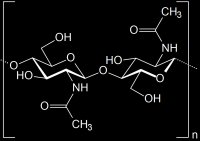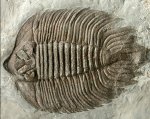 Trilobite
Exoskeleton Origins
Trilobite
Exoskeleton Origins
One
of life's most important evolutionary adaptations was the emergence
of the external skeleton, or exeskeleton, presumably in the
earliest part of the Cambrian known as the Cambrian Explosion.
It is not
a coincidence that the early Cambrian marks the beginning
of the "macroscopic fossil record". That trilobites
first appear in the fossil record already
highly diverse
and spread geographically is precisely due to its readily
preserved, hard external skeleton. Most trilobite fossils are,
in fact,
the preserved
exeskeletons. Only under rare circumstances have the soft
body parts of trilobites (and other arthropods) been preserved
as
fossils. The Precambrian fossil record is extremely poor,
and many putative precambrian fossil equivocal at least partly
because that lacked hard parts.
There
are different hypotheses on the origins of the arthropod exoskeleton
in the Precambrian. There is  concensus that Arthropoda is monophyletic,
and that the Onychophorans (velvet worms) and Arthropoda are
sister groups descended from
annelids (phylum Annelida), and a member of Superphylum Ecdysozoa,
a clade (Aguinaldo,
1997) with a common ancestor comprising animals with a cuticle
that periodically molted as the animal
grows. Interestingly, the Onychophorans, besides leg having
similar structure, locomotion, and embryology similar to myriapods
(Anderson,
1973), have exoskeletons. Ribosomal RNA analysis of velvet
worms and other arthropods also suggests close
affinity
between
them (Ballard et
al. 1992). The velvet worm exoskeleton is a one mm thick chitin
and protein layer resembling that of some arthropods. Without
a doubt, arthropod phylogeny is problematic, but that the trilobite
exoskeleton has origins in Phylum Onychophora is plausible conjecture.
concensus that Arthropoda is monophyletic,
and that the Onychophorans (velvet worms) and Arthropoda are
sister groups descended from
annelids (phylum Annelida), and a member of Superphylum Ecdysozoa,
a clade (Aguinaldo,
1997) with a common ancestor comprising animals with a cuticle
that periodically molted as the animal
grows. Interestingly, the Onychophorans, besides leg having
similar structure, locomotion, and embryology similar to myriapods
(Anderson,
1973), have exoskeletons. Ribosomal RNA analysis of velvet
worms and other arthropods also suggests close
affinity
between
them (Ballard et
al. 1992). The velvet worm exoskeleton is a one mm thick chitin
and protein layer resembling that of some arthropods. Without
a doubt, arthropod phylogeny is problematic, but that the trilobite
exoskeleton has origins in Phylum Onychophora is plausible conjecture.
Trilobite Exoskeleton Prosopon
Prosopon
are features on the trilobite exoskeletons that are usually
smaller and include nodes,
perforations, pitting, and pustules, and generally exclude larger
features such as pleural
spines. In general, the purposes of prosopon as evolutionary
adaptations features remain equivocal. They have some use as
diagnostic
features
in identification
and classification, but caution must be used as proposon attributes
are in a broad sense shared across all of Trilobita. The ubiquitous
nature of the prosopon suggest they arose independently and
multiple times in different orders exposed
to the same environments and selective pressures, an example
of parallel evolution.
Tubercles
 Tubercles
are found in many trilobite families and species, and are particularly
common and pronounced in orders Lichida
(see Artinurus
boltoni) and Phacopida. Tubercles are also prevalent among
Proetids (see Proetus
tuberculatus morocensis , a trilobite actually named the
tubercules on its cephalon. Why tubercles evolved is uncertain,
but scientists have
conjectured
they
may
have provided
a measure
of camouflage,
especially when combined with color patterning. Similarly, tubercles
may have made it more difficult for tentacled predators such
as nautiloids to get a firm grasp on them. Tubercles vary in
morphology small dome-like nodes to short spikes. Tubercles,
especially smaller ones, are often called granules, and terminology
such tuberculose or granulous exoskeleton will be seen.
Tubercles
are found in many trilobite families and species, and are particularly
common and pronounced in orders Lichida
(see Artinurus
boltoni) and Phacopida. Tubercles are also prevalent among
Proetids (see Proetus
tuberculatus morocensis , a trilobite actually named the
tubercules on its cephalon. Why tubercles evolved is uncertain,
but scientists have
conjectured
they
may
have provided
a measure
of camouflage,
especially when combined with color patterning. Similarly, tubercles
may have made it more difficult for tentacled predators such
as nautiloids to get a firm grasp on them. Tubercles vary in
morphology small dome-like nodes to short spikes. Tubercles,
especially smaller ones, are often called granules, and terminology
such tuberculose or granulous exoskeleton will be seen.